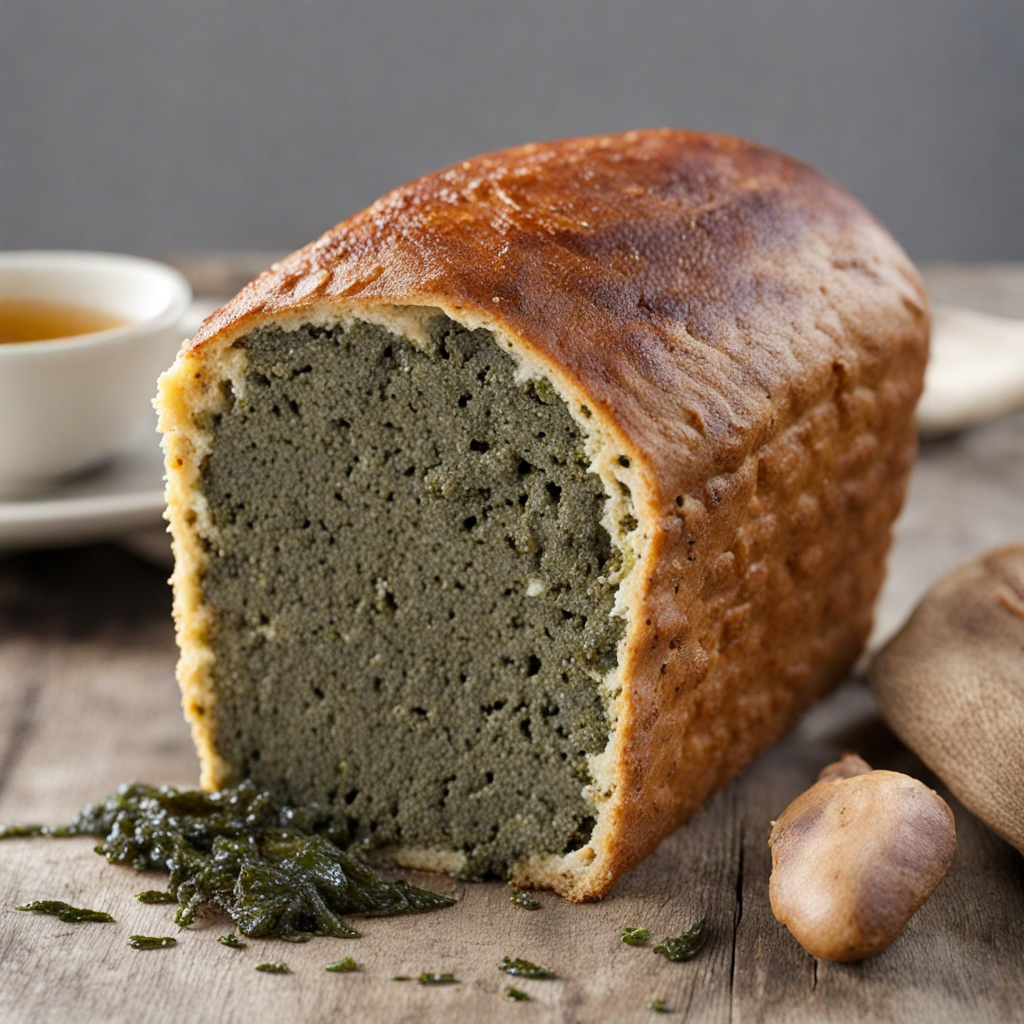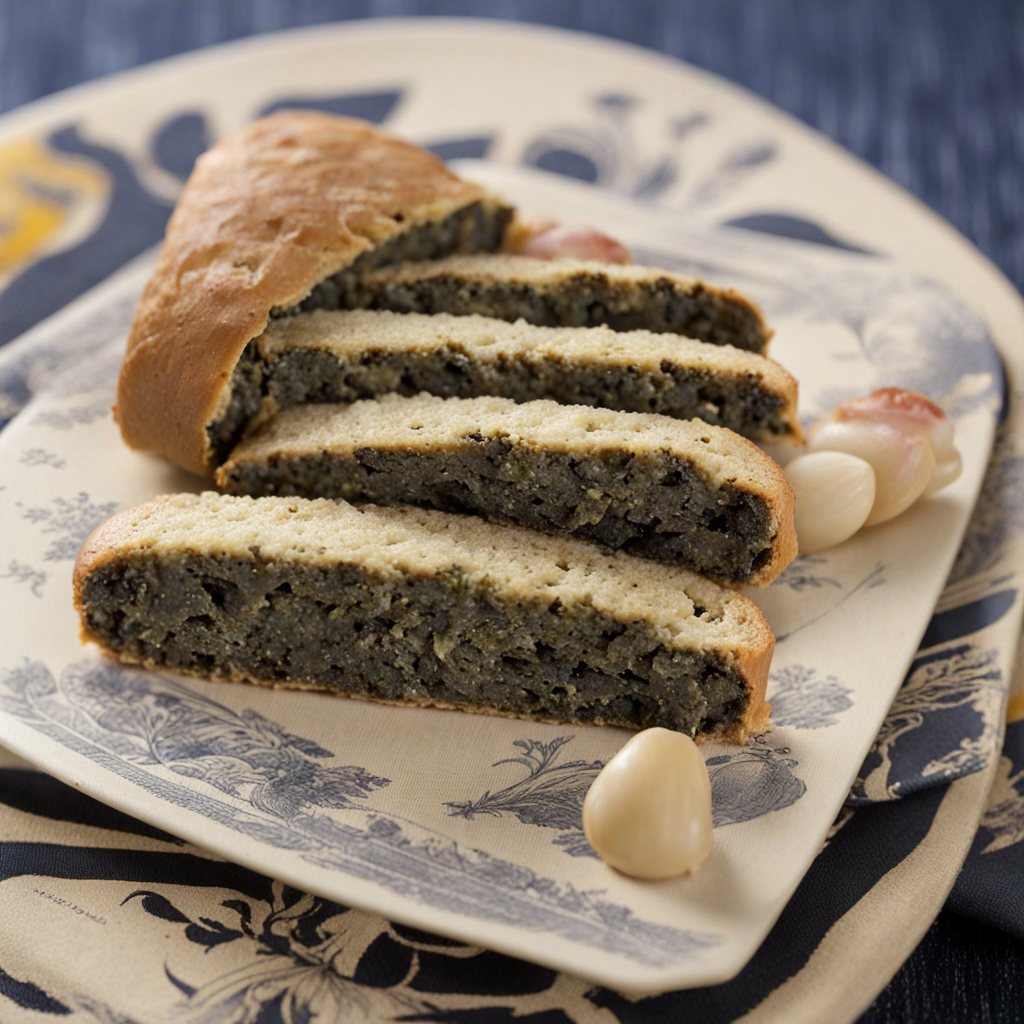Laverbread
Laverbread is a unique delicacy hailing from the coastal regions of Wales, particularly celebrated for its rich, nutty flavor and distinctive texture. Made from laver, a type of edible seaweed, this dish is often cooked down to a soft, almost paste-like consistency. The seaweed is typically harvested, cleaned, and then slow-cooked until it reaches a tender state, resulting in a dark green, earthy product that brings the essence of the ocean to the plate. The flavor is reminiscent of the sea, with a subtle umami quality that resonates beautifully with a variety of accompaniments. Traditionally, laverbread is served as part of a hearty Welsh breakfast, often accompanied by ingredients like cockles, bacon, and fried eggs. It can also be enjoyed as a spread on toast or incorporated into other dishes, adding a unique twist to classic recipes. The versatility of laverbread allows it to shine in both savory and sweet applications, making it an exciting ingredient for adventurous home cooks and food enthusiasts alike. Aside from its delightful taste, laverbread is also packed with nutritional benefits, being rich in vitamins and minerals, particularly iodine and iron. This makes it not only a flavorful addition to meals but also a healthful one, appealing to those looking to incorporate more sea vegetables into their diet. Whether you're savoring it in a traditional setting or experimenting with modern culinary techniques, laverbread offers a taste of Wales that is both distinct and memorable.
How It Became This Dish
Laverbread: A Culinary Treasure of Wales Origins and Early History Laverbread, or "bara lawr" in Welsh, is a unique and traditional dish from Wales that embodies centuries of culinary heritage. The dish is made from laver (Porphyra umbilicalis), a type of edible seaweed that thrives along the rocky shores of the British Isles. Laver has been harvested and consumed for centuries, with its roots extending back to the early Celtic tribes who inhabited the region. Archaeological evidence suggests that seaweed was a staple for coastal communities, providing essential nutrients in a time when food preservation was limited. The harvesting of laver likely began as a necessity for sustenance, with the Welsh people utilizing the abundant natural resources provided by the sea. Its use is documented in Welsh literature, notably in the "Llyfr Coch Hergest," a medieval manuscript that contains recipes and references to local cuisine. As such, laverbread is not just food; it is a living testament to the resourcefulness and adaptability of the Welsh people. Cultural Significance Laverbread is more than just a dish; it is a cultural icon deeply intertwined with Welsh identity. Traditionally served as a breakfast item, it is often paired with cockles and bacon, creating a hearty meal that reflects the coastal lifestyle of Wales. The dish embodies the concept of "cuisine de terroir," where local ingredients are celebrated and incorporated into daily life. In many ways, laverbread encapsulates the spirit of Wales, where the rugged coastline and the sea have shaped both the landscape and the culinary practices of its inhabitants. As a result, it holds a special place in the hearts of the Welsh people, symbolizing resilience, connection to nature, and pride in local traditions. Preparation and Culinary Techniques The preparation of laverbread is a meticulous process that showcases traditional Welsh culinary techniques. First, the seaweed is collected during low tide, often by local harvesters who have honed their skills over generations. Once gathered, the laver is washed thoroughly to remove any sand and debris. It is then cooked in boiling water until it becomes soft and gelatinous. After cooking, the laver is typically pureed or chopped finely before being shaped into cakes or patties. In some regions, it is mixed with oatmeal and fried, resulting in a dish with a distinctive taste and texture. The final product is dark green, almost black in color, with a slightly salty and earthy flavor that can be polarizing to those unfamiliar with it. Traditionally, laverbread is served hot, often garnished with a drizzle of lemon juice or accompanied by crusty bread. It can also be used as a component in various dishes, such as soups, salads, or as a filling for savory pastries. This versatility has contributed to its enduring popularity within Welsh cuisine and beyond. Evolution and Modern Adaptations As with many traditional foods, laverbread has undergone various transformations over time. While it has remained a staple in Wales, its popularity has ebbed and flowed throughout the years. In the 19th and early 20th centuries, the industrial revolution and the rise of convenience foods led to a decline in the consumption of traditional dishes like laverbread. Many younger generations began to move away from their culinary heritage, opting for processed foods that were easier to prepare and more widely available. However, the late 20th century saw a resurgence of interest in traditional Welsh cuisine, coinciding with a broader movement toward local, sustainable, and organic foods. Chefs and food enthusiasts began to recognize the value of laverbread, not just for its nutritional benefits but also for its distinctive flavor and cultural significance. Restaurants and food festivals across Wales began to celebrate the dish, often incorporating it into modern interpretations of Welsh fare. Today, laverbread is often featured on menus in upscale restaurants and gastropubs, where chefs experiment with innovative presentations and flavor pairings. It is not uncommon to find laverbread served alongside smoked salmon, in gourmet salads, or even as a contemporary twist on traditional Welsh dishes like cawl (a hearty Welsh stew). This evolution demonstrates the adaptability of laverbread, allowing it to maintain relevance in a rapidly changing culinary landscape. Global Recognition and Future Prospects In recent years, laverbread has garnered attention beyond the borders of Wales. As the global food movement continues to embrace local and sustainable ingredients, chefs and home cooks alike are discovering the unique qualities of this seaweed-based dish. Laver, known for its high nutritional value, including vitamins A, C, and E, as well as essential minerals, is being touted as a superfood. This has led to increased interest in integrating laver into various cuisines, from Asian to Mediterranean dishes. Moreover, the rise of plant-based diets and the growing awareness of the environmental impact of food production have positioned laverbread as a sustainable choice. Seaweed is a renewable resource that requires minimal agricultural inputs, making it an appealing option for health-conscious and environmentally aware consumers. While laverbread may have its roots in Welsh tradition, its future seems bright. As more people seek authentic and diverse culinary experiences, this distinctive dish has the potential to reach new audiences, fostering appreciation for Welsh culture and cuisine. The ongoing exploration of traditional foods also empowers local communities, encouraging the continuation of age-old practices and the preservation of culinary heritage. Conclusion Laverbread is much more than just a dish; it is a symbol of Welsh identity, resilience, and connection to the land and sea. Its rich history, cultural significance, and evolving nature reflect the story of Wales itself—one of adaptation, pride, and a deep appreciation for local resources. As it continues to find its place in modern kitchens and restaurants, laverbread stands as a testament to the importance of culinary traditions and their role in shaping our understanding of food and culture. In a world increasingly defined by globalization and homogenization, the resurgence of laverbread serves as a reminder of the value of local heritage and the joy of celebrating the flavors of the past.
You may like
Discover local flavors from United Kingdom







